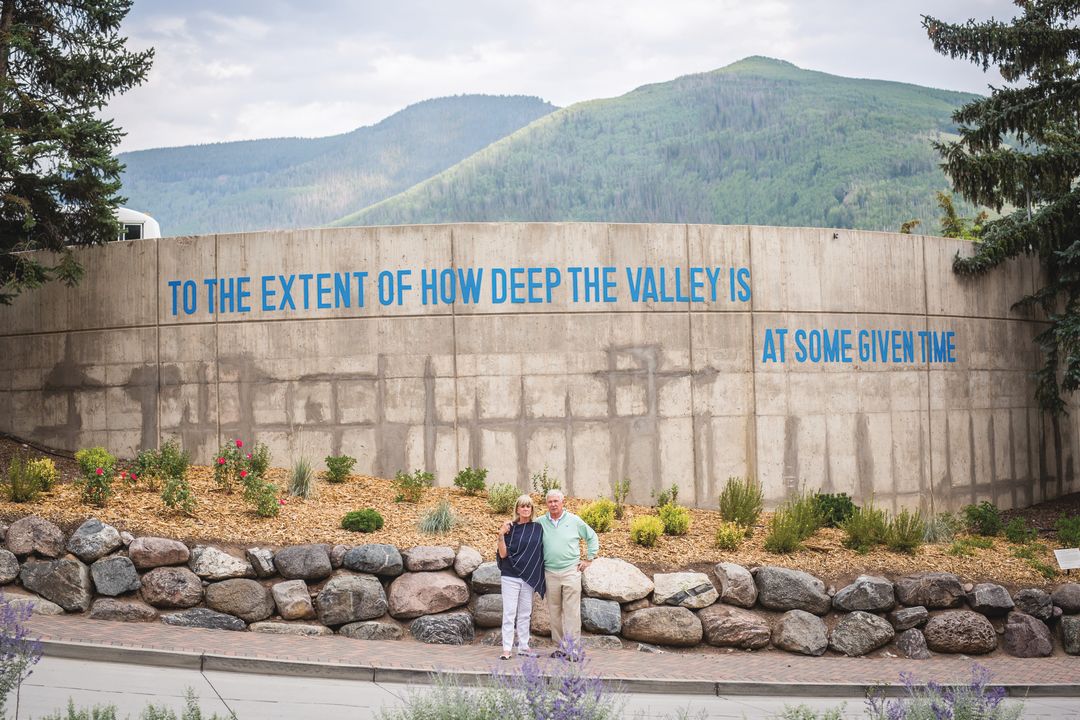Vail's Museum Without Walls

Art in Public Places patrons Vicki and Kent Logan with the conceptual artwork by Lawrence Weiner they gifted to the Town of Vail in 2018.
Unlike Aspen, the Town of Vail might not have an art museum per se, but it does have Art in Public Places (AIPP, artinvail.com), an outdoor gallery exhibiting a collection of more than 70 publicly accessible sculptures, paintings, and murals scattered throughout the ski villages, East Vail and West Vail. Most visible, perhaps, is the cluster of more than a dozen works in and around the Vail Village Transportation Center, including Paul Vexler’s Red Eddy, a Calder-like mobile dangling above the Welcome Center’s information kiosk, and a head-scratcher of a conceptual artwork by Lawrence Weiner, a cryptic message in all caps and blue serif etched in concrete (“TO THE EXTENT OF HOW DEEP THE VALLEY IS AT SOME GIVEN TIME”) just outside the parking structure’s main entrance. The marquee location practically guarantees heavy foot (and vehicular) traffic, and thus a captive audience. “In a way, we’ve made a little cultural entrance to the village,” says Town of Vail AIPP Coordinator Molly Eppard. “We’ve often called it a museum without walls. It’s a first impression, but it’s also a last impression.”
The last several months have brought big acquisitions, and there’s more good news on the horizon. Kent and Vicki Logan, longtime Vail Valley residents and prolific contemporary art collectors, recently donated another five pieces from their prodigious collection of more than 1,200 pieces (they gifted the Weiner work in 2018) after downsizing from a home with a 6,000-square-foot gallery in West Vail to a modest residence in Arrowhead. The first four—a cluster of birdhouses called We are all building nests by Jason Middlebrook, an eight-foot-tall bronze called Killer Whale Totem by Preston Singletary, a contemplative bronze called Two Vessels by Nathan Mabry, and a 10-foot-tall bronze called Waqui Totem USA (Urban Class Mark V) by Brad Kahlhamer—were installed this past summer on the south side of the parking structure off East Meadow Drive.
“The Logans have identified the Denver Art Museum, SFMOMA, and the Phoenix Art Museum as three of the big institutions where their gifts and collection will reside,” explains Eppard. “Kent and Vicki don’t want their works to end up in storage. We feel really lucky that they will consider Vail for their sculptures.”
In their own way, each of their pieces emphasize a connection with nature and its viewer. “People really seem to connect with the birdhouse sculpture and its iconic forms of architecture,” says Eppard. “I was giving a tour of the collection the other day and people from Texas recognized the Alamo, others say ‘Look, the Taj Mahal.’”
And the works keep accumulating. In November, AIPP commissioned Park City artist Lamont Joseph White to paint a canvas celebrating the National Brotherhood of Skiers’ history in Vail (see “Soul Patrol,” p. 46) that will become part of the town’s permanent collection, which in May will expand to include Yoram Wolberger’s Male Baseball #1, a trophylike sculpture that will be installed near the ballfields in Ford Park. Over the summer, AIPP also announced plans for an artist in residency program (underwritten in part by the Logans) with a studio space in Ford Park that will be designed by Harry Teague Architects of Basalt.
“We really want to make this a studio that will attract artists who are looking for a retreat experience, to get out of their regular routine, and work along Gore Creek,” says Eppard, who envisions that the studio will become an integral stop on AIPP’s popular summertime walking tours of the collection.






































